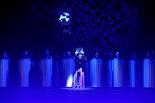In her memoirs, the singer Régine Crespin recounts that during the time she played the role of Kundry at Bayreuth (1958-1961), no applause was to be given at the end of the performance: Wagner himself did not want to alter the intense religiosity of his work. The famous soprano had to wait, she explains, until the following year to receive during her interpretation of Sieglinde in 1961 at the Festspielhaus, all the “applause accumulated over the past four years.” Thus, this Parsifal premiere at the Nice Opera was eagerly awaited. The change of venue—Acropolis instead of the establishment on Rue Saint-François-de-Paule—signaled the scale of the scenic and orchestral dimension. The coldness of the Apollon room perfectly suited the demands of quasi-liturgical purity contained in this Wagnerian drama: a divine redemption achieved through intense human struggle among the knights in quest of the Grail.
For Parsifal holds a unique place in the repertoire of the master from Leipzig: not only because it is the last opera composed by Richard Wagner, who would die a year later. But this piece stands out mainly for its absolute inwardness: no dazzling actions in cascades mingling gods and humans, no hypertrophied exacerbation of romantic passions leading to a deadly outcome. Ultimately, no projective dramaturgy where the viewer is swept away, gripped by the orchestral power’s onslaught. No.
In this sense, this co-production of the Nice Opera with the Grand Théâtre de Genève and the Leipzig Opera respects the fundamental rule of this work: it is the emotionally moved audience that desires to step onto the stage to join in this form of musical Eucharist. Despite some criticisms heard here and there—a somewhat rapid tempo or too much immobility, depending!—conductor Philippe Auguin—undoubtedly a maestro to be heard more about shortly, who has finally garnered unanimous enthusiasm at the Nice Philharmonic—managed to read and perform this score in a linear atmosphere, slightly progressive in its meditative approach to accompany, without mannerism or weariness, this inexorable journey towards transcendence. Music reflecting that transparent veil separating the stage from the audience without causing any discomfort: a reminder of the necessary distance intended to mark the divide between the profane and the sacred.
The harmonious distribution of voices is not the least of the assets in the success of this performance: American Gary Lehman, whose intense voice and incredible baritone range facilitate an easy interpretation of Wagnerian tenor roles, skillfully uses this expanded range to illustrate the striking transformation of Parsifal’s character between the first and third acts. Russian mezzo-soprano Elena Zhidkova also superbly accompanies this entirely inner transformation, vocally transitioning from shadowy tones to redemptive clarity, while skillfully maintaining more terrestrial intonations that suit Kundry’s affective, human ambivalence. Finnish bass Jukka Rasilainen portrays a magnificent Amfortas with a dark, powerful voice endowed with stable and moving low notes. Kurt Rydl deserves praise for his role as Gurnemanz and his efforts to effectively combat the barely noticeable effects of his sinusitis.
Nevertheless, there remains much criticism regarding the staging and sets. Roland Aeschlimann is certainly not a novice, but Dagmar Pischel makes the glaring error of attempting to impose rather than suggest, aiming to let the public be overwhelmed by the Christic symbolism: thus, the first act fails the supposed mystical amazement of the knights’ gathering, who comically lean from one side to another during the ceremony. What can also be said about the perplexing sets? A replica of the “Stargate portal”—apparently it’s the cavity of a camera lens—to metaphorize the inner journey, a Grail reduced to an image of Christ projected in a technically unstable play that removes all its mysterious solemnity, a final scene replaying the Pietà in an artificial way: this Nice Parsifal could easily convince without the abuse of these dubious artifices.


